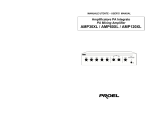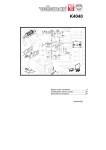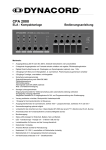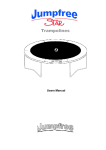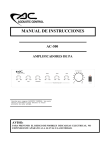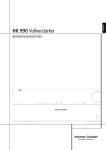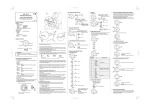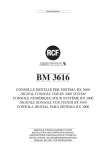Download Dynacord Stereo Amplifier MIXER AMPLIFIER User's Manual
Transcript
MIXER AMPLIFIER MV 503 MV 506 MV 512 Bedienungsanleitung Owner’s Manual Mode d’emploi Merkmale: • • 1 Eingang für 6,3mm Klinke, symmetrisch, umschaltbar Line/Mikro • 1 Eingang für 6,3mm Klinke, unsymmetrisch, umschaltbar Line/Mikro • 1 Cinch-Stereoeingang Line • 1 Ausgang “PRE OUT” • 1 Ausgang “TAPE OUT” • • 1 Eingang “MAIN IN” • • Vorrang der Eingänge 1, 2, 3 auf die anderen Eingänge, Kontaktaktivierung • Summensteller Höhen, Bässe und Lautstärke • Schutz gegen Kurzschluss am Ausgang • LED-VU-Meter • Zusätzlicher Ausgang für Funktion “Music on hold” • • Netzbetrieb 115/230V umschaltbar 2 XLR-Mikrofoneingänge, symmetrisch, mit abschaltbarer “Phantom”-Speisung mit 24V dc. Vorrang des Eingangs 1 auf die anderen Eingänge, Sprachaktivierung Lautsprecherausgänge niederohmig (4Ohm) und hochohmig (25-70-100V) Batteriebetrieb 24V Inhaltsverzeichnis Bedienungselemente und Funktionen . . . . . . . . . . . . . . . . . . . . . . . . . . . . . . . . . . . . . . Frontseite . . . . . . . . . . . . . . . . . . . . . . . . . . . . . . . . . . . . . . . . . . . . . . . . . . . . . . . . . . . . Rückseite . . . . . . . . . . . . . . . . . . . . . . . . . . . . . . . . . . . . . . . . . . . . . . . . . . . . . . . . . . . . Speisung mit Wechselstrom . . . . . . . . . . . . . . . . . . . . . . . . . . . . . . . . . . . . . . . . . . . . . . Speisung mit Gleichstrom. . . . . . . . . . . . . . . . . . . . . . . . . . . . . . . . . . . . . . . . . . . . . . . . Technische Daten. . . . . . . . . . . . . . . . . . . . . . . . . . . . . . . . . . . . . . . . . . . . . . . . . . . . . . Anschlußbeispiele . . . . . . . . . . . . . . . . . . . . . . . . . . . . . . . . . . . . . . . . . . . . . . . . . . . . . Blockdiagramm. . . . . . . . . . . . . . . . . . . . . . . . . . . . . . . . . . . . . . . . . . . . . . . . . . . . . . . . Garantie . . . . . . . . . . . . . . . . . . . . . . . . . . . . . . . . . . . . . . . . . . . . . . . . . . . . . . . . . . . . . 3 3 4 7 7 8 25 26 28 WICHTIGE SICHERHEITSHINWEISE Das Blitzsymbol innerhalb eines gleichseitigen Dreiecks soll den Anwender auf nicht isolierte Leitungen und Kontakte im Geräteinneren hinweisen, an denen hohe Spannungen anliegen, die im Fall einer Berührung zu lebensgefährlichen Stromschlägen führen können. 1. Lesen Sie diese Hinweise bitte aufmerksam. 2. Bewahren Sie diese Hinweise auf, so daß Sie diese gegebenenfalls später nochmals lesen können.. 3. Beachten Sie alle Warnhinweise am Gerät und in der Bedienungsanleitung. 4. Betreiben Sie dieses Gerät nicht in der Nähe von Wasser. 5. Verdecken Sie keine Ventilationsöffnungen. Installieren Sie das Gerät gemäß den Hinweisen des Herstellers. 6. Wenden Sie sich bei Reparaturen und Serviceleistungen an einen qualifizierten Servicetechniker. 2 Das Ausrufezeichen innerhalb eines gleichseitigen Dreiecks soll den Anwender auf wichtige Bedienungs- sowie Servicehinweise, in der zum Gerät gehörenden Literatur, aufmerksam machen. FRONTSEITE BEDIENUNGSELEMENTE UND FUNKTIONEN 1. Lautstärkesteller für die Eingänge Diese Drehknöpfe erlauben die unabhängige Einstellung der Lautstärke der an die Eingänge “IN1", ”IN2", “IN3, IN4", “AUX IN” angeschlossenen Schallquellen. Durch die Rechtsdrehung jedes Knopfes wird die Lautstärke erhöht. Es wird empfohlen, den Knopf auf 0 zu stellen, wenn der betreffende Eingang nicht verwendet wird. 2. Summen-Klangsteller BÄSSE Der Drehknopf verstärkt die tiefen Frequenzen (Rechtsdrehung) oder schwächt sie ab (Linksdrehung). Wenn sich der Drehknopf in der Mittelstellung befindet, wird der Frequenzgang nicht beeinflußt. 3. Summen-Klangsteller HÖHEN Der Drehknopf verstärkt die hohen Frequenzen (Rechtsdrehung) oder schwächt sie ab (Linksdrehung). Wenn sich der Drehknopf in der Mittelstellung befindet, wird der Frequenzgang nicht beeinflußt. 4. Summen-Lautstärkesteller MASTER Der Drehknopf dient zur Einstellung der Lautstärke am Lautsprecherausgang “OUTPUT” . Es wird empfohlen, extreme Einstellungen zu vermeiden, bei denen die allgemeine Lautstärke auf das Maximum und die Bedienungselemente der einzelnen Eingänge auf das Minimum gestellt sind, oder umgekehrt. 5. Kontrolleuchte ON Die Kontrolleuchte leuchtet auf, wenn der Verstärker eingeschaltet ist. 6. Schalter “POWER” Ein- und Ausschalten des Gerätes. 7. LED-VU-Meter Zeigt den Signalausgangspegel an. Für eine korrekte Verwendung des Verstärkers ist es wichtig, daß die Lautstärke so eingestellt wird, daß der Ausgangspegel im Bereich zwischen -20 dB und 0 dB liegt, der von den ersten 5 Leds angezeigt wird. Längeres Aufleuchten der letzten 2 Leds (+3dB und +6dB) zeigt an, daß das Ausgangssignal verzerrt ist; die Lautstärke muß verringert werden. 3 RÜCKSEITE SICHERUNGSWERTE 8. Sicherung Bei Defekten oder bei Anschlußspannungswechsel darf das Ersetzen der Sicherung nur durch einen Fachmann erfolgen. Der neue Sicherungswert muß per Aufkleber auf der Rückwand angegeben werden. 9. Umschalter DC - AC 230V 115V MV 512 2,5A 5A MV 506 1,6A 3,15A MV 503 1A 2A Mit diesem Schalter kann die Batteriespannung Ein-und Ausgeschaltet werden. 10. Netzspannungs-Umschalter Das Gerät ist ab Werk auf 230V AC eingestellt. Eine Umschaltung auf 115V AC kann mit diesem Schalter vorgenommen werden. Dazu muß die Abdeckung mit Hilfe eines Schraubendrehers geöffnet werden. 11. Ausgang “TAPE OUT” Die Steckbuchsen “R” und “L” gestatten die Ansteuerung der Eingänge des rechten (“R”) und linken (“L”) Kanals eines Aufzeichnungsgerätes mit dem gemischten Signal der an die Verstärkereingänge angeschlossenen Schallquellen. Sie sind für koaxiale Cinch-Verbindungen vorbereitet; das vorhandene Signal ist unsymmetrisch. Die Eingangsimedanz des Aufzeichnungsgerätes muß über 4,7 kOhm liegen. 12. Eingänge “AUX IN” (INPUT 5) Die Steckbuchsen “R” und ‘L" gestatten den Eingang des rechten (“R”) und linken (“L”) Kanals einer Audioquelle mit hochpegeligem Signalausgang (z.B. AM/FM-Empfangsgerät, Kassettenrecorder, CD-Player, usw.). Sie sind für koaxiale Cinch-Verbindungen und unsymmetrische Signale vorbereitet. 13. Empfindlichkeitsschalter für Eingang “IN 4" Durch die Schaltung auf “MIC” kann der Eingang “IN4" an ein niederohmiges dynamisches Mikrofon angeschlossen werden; die Schaltung auf ”LINE" erlaubt den Anschluß des Einganges “IN4" an eine Audioquelle mit hochpegeligern Signalausgang. 14. Eingang “IN4" Dieser unsymmetrische Eingang kann für den Anschluß eines dynamischen Mikrofons verwendet werden (30-600 Ohm), oder für eine Audioquelle mit hochpegeligem Signalausgang (z.B. AM/FM-Empfangsgerät, Kassettenrecorder, CD-Player, usw.).Er ist für 6,3 mm-Klinkenstecker vorbereitet. Zur Einstellung der Eingangsempfindlichkeit ist der Schalter (13) zu betätigen. 15. Schalter “XLR PHANTOM 24 V” Auf der Schalterstellung “ON” wird die Phantom"-Speisung mit 24V auf den Pins 2 und 3 der Eingänge “IN2", ”IN3" (16) eingeschaltet. Dadurch können Kondensatormikrofone angeschlossen werden, für die eine solche Speisung erforderlich ist. Beim Umschalten sollte die allgemeine Lautstärke auf das Minimum eingestellt sein. 16. Eingänge “IN2" - ”IN3" An diese symmetrischen Eingänge können dynamische Mikrofone angeschlossen werden (30—.600 ohm), oder Kondensatormikrofone mit “Phantom”-Speisung von 24V. Sie sind für dreipolige “XLR”-Verbindungen. Die Einschaltung der “Phantom”-Speisung mit 24V erfolgt über den Schalter (15). HINWEISE Unsymmetrische Mikrofone dürfen bei eingeschalteter “Phantom’-Speisung nicht angeschlossen werden; sie könnten sonst beschädigt werden. Das Einstecken und Herausziehen der Mikrofonkabel muß bei abgeschalteter “Phantom”-Speisung erfolgen. Stellen Sie sicher, daß die “Phantom”-Speisung abgeschaltet 4 ist, wenn Mikrofone verwendet werden, die keine externe Speisung erfordern: die auf den Anschlüssen 2 und 3 der XLR-Steckbuchse vorhandene Spannung könnte sonst schwere Schäden verursachen. 17. Empfindlichkeitsschalter für Eingang “IN1" Durch die Schaltung auf “MIC” kann an den Eingang “IN1" ein dynamisches Mikrofon angeschlosen werden; die Schaltung auf “LINE” erlaubt den Anschluß des Einganges “IN1" an eine Audioquelle mit hochpegeligern Signalausgang. 18. Eingang “IN1” Dieser symmetrische Eingang kann für den Anschluß eines dynamischen Mikrofons verwendet werden (30-600 Ohm), oder einer Audioquelle mit hochpegeligem Signalausgang (z.B. AM/FM-Empfangsgerät, Kassettenrecorder, CD-Player, usw.). Er ist für 6,3 mm-Klinkenstecker vorbereitet. Zur Einstellung der Eingangsempfindlichkeit ist der Schalter (17) zu betätigen. Der Eingang ist mit der Funktion “Voice Priority” ausgestattet, welche sämtliche anderen Eingänge ausschaltet, sobald eine Mikrofonansage ausgestrahlt wird. Diese Funktion kann durch eine DYNACORDKUNDENDIENSTSTELLE ausgeschaltet werden. 19. Steckbuchse Eingang Netzkabel In diese Steckbuchse muß das mitgelieferte Netzkabel eingesteckt werden. 20. Klemmen für Gleichstromspeisung Die beiden Klemmen erlauben die Speisung des Verstärkers durch eine externe Gleichstromquelle von 24 VDc (z.B. eine 24 VDc-Batterie). Auf diese Weise kann das Gerät bei Wechselstromausfällen zur Gewährleistung eines unterbrechungsfreien Betriebes automatisch mit Gleichstrom gespeist werden. HINWEISE Das Gerät ist nicht mit einer Ladevorrichtung für die Batterie ausgestattet, aus diesem Grunde sollte ein entsprechendes Gerät bereitgestellt werden. Bei mit Gleichstrom gespeistem Verstärker wird die Nominalleistung um etwa 20% herabgesetzt. 21. Ausgangsklemmen 22. Klemme “COM” Gemeinsame Klemme für die Ausgänge (23) und (24). 5 23. Ausgangsklemme für zusätzlichen Lautsprecher An dieser Klemme kann ein kleiner zusätzlicher Lautsprecher angeschlossen werden; dieser wird mit dem gemischten Signal der Eingänge “IN4" und ”AUX-IN" angesteuert, über den geräteintern vorhandenen zusätzlichen Verstärker mit 1 W-Nominalleistung. Das Ausgangssignal unterliegt nur der Lautstärkeregulierung der Eingänge “IN4" und ”AUX-IN". 24. Ausgangsklemme “0 dB” Diese Klemme gibt ein unsymmetrisches Signal aus der Mischung der Eingänge “IN4" und ”AUX-IN" zum Nominalpegel von 0 dB ab. Sie kann für die Ansteuerung eines Audiogerätes mit einer Eingangsimpedanz über 600 Ohm verwendet werden (zusätzlicher Verstärker, Telefonzentrale, usw.). Das Ausgangssignal unterliegt nur der Lautstärkeregulierung der Eingänge “IN4" und ”AUX-IN". 25. Klemme “VOICE PRIORITY” Durch Kurzschließen dieser Klemme mit der Klemme “COM” (z.B. anhand eines elektrischen Kontaktes) werden die Eingänge “IN4" und ”AUX IN" ausgeblendet (keine Signalausstrahlung) und den Eingängen “INI”, “IN2" und “IN3" der Vorrang gelassen. 26. Klemme “COM” Gemeinsame Klemme für die Ausgänge (25), (27) und (28). 27. Klemme “PRE OUT” Diese Klemme gibt das Signal aus der Mischung aller Verstärkereingänge ab. Der Ausgang kann zur Ansteuerung eines Leistungsverstärkers, eines externen Signalprozessors (z.B. Equalizer) oder eines anderen Gerätes verwendet werden. Das unsymmetrische Signal wird mit den Lautstärkereglern der Eingänge, den Klangreglern und der Summenregler eingestellt. Zur Verwendung des Ausganges ist die Brücke zu entfernen, die ihn mit dem Eingang “MAIN IN” verbindet. 28. Klemme “MAIN IN” Durch das Entfernen der Brücke, die diesen Eingang mit dem Ausgang “PRE OUT” verbindet, kann ein externer Signalprozessor (z.B. Equalizer) zwischen die Vorverstärkerstufe und die Leistungsstufe des Verstärkers eingeschaltet werden. Diese Lösung eignet sich überall dort wo eine akustische Signalverbesserung (Nachhallbeseitigung, Equalizer, Larseneffekt-Unterdrückung, usw.) notwendig ist. Der Eingang ist unsymmetrisch. 29. Schraube “GND” Mit dieser Schraube kann das Chassis des Gerätes geerdet werden, wenn die Steckdose, die für die Stromversorgung verwendet werden soll, keinen Erdungspol besitzt. Der Anschluß darf nur von einem qualifizierten Elektriker durchgeführt werden. INSTALLATIONSHINWEISE Zur Gewährleistung einer ordnungsgemäßen Kühlung der Endstufen, muß der Verstärker an einem gut belüfteten Ort, vor direkter Sonnenbestrahlung geschützt und von Wärmequellen fern aufgestellt werden. Vermeiden Sie es, den Lautsprecher an Orten aufzustellen, wo sehr hohe Schwingungen und besonders viel Staub und Feuchtigkeit vorhanden sind. 6 ACHTUNG Es wird empfohlen, den Geräteanschluß ausschließlich von qualifizierten Fachkräften vornehmen zu lassen, die eine ausreichende technische Kenntnis, Erfahrung oder Fachausbildung besitzen um die Anschlüsse richtig auszuführen und so Stromgefahren vorzubeugen. Um die Gefahr von Stromschlägen zu vermeiden darf der Verstärker erst nach Beendigung aller Anschlüsse an das Stromnetz angeschlossen werden. Vor dem Anschluß an die Netzspannung sind alle Anschlüsse erneut zu kontrollieren und besonders gut zu überprüfen, daß keine Kurzschlüsse bestehen. Die gesamte Beschallungsanlage muß in Übereinstimmung mit den für Elektroanlagen gültigen Normen und Gesetzesvorschriften ausgeführt werden. SPEISUNG MIT WECHSELSTROM ACHTUNG Prüfen Sie vor Inbetriebnahme des Gerätes, daß die Netzspannung der am Spannungswähler (8) eingestellten Spannung entspricht. Wenden Sie sich andernfalls an Ihren DYNACORD-Händier. Betreiben Sie das Gerät nur an geerdeten Steckdosen. Zum Anschluß an das Wechseistromnetz bei 115 oder 230 Vac muß das beigestellte Kabel verwendet werden, das zuvor an die Steckbuchse (19) des Gerätes angeschlossen werden muß. Das Gerät ist serienmäßig auf 230V Betriebsspannung eingestellt. Die Umstellung auf 115V darf nur von einem Fachmann vorgenommen werden. Dazu muß die Abdeckung mit Hilfe eines Schraubendrehers geöffnet werden. SPEISUNG MIT GLEICHSTROM ACHTUNG Zu verwenden sind die Klemmen (20), die sich unter der Schutzabdeckung befinden und an eine Speisequelle von 24VDc (z.B. Batterie) anzuschließen sind. Um Spannungsabfälle auf ein Minimum herabzusetzen und um Überhit2 zungen an den Anschlußkabeln zu verhindern, müssen die Anschlußkabel einen Mindestquerschnitt von 2,5 mm aufweisen. Die Ein- und Ausschaltung des Gerätes erfolgt über den Schalter (6). AUSSCHALTEN DES AUTOMATISCHEN VORRANGES FÜR EINGANG “IN1" Um bei einer Durchsage mit Eingang”IN1" das Abschalten aller anderen Eingänge zu vermeiden, kann im Geräteinneren eine Umprogrammierung auf Mischbetrieb vorgenommen werden. 1. Abtrennen aller Spannungsquellen vom Gerät. 2. Gerätedeckel mit 3 Schrauben auf jeder Seite lösen und abnehmen. 3. Auf der Eingangsleiterplatte den Stecker CN7/Voice auf “disable” umstecken (siehe Abb.). 4. Gerätedeckel wieder ordnungsgeäß befestigen. EINSTELLEN DER EMPFINDLICHKEIT FÜR DIE FUNKTION “VOICE PRIORITY” 1. Abtrennen aller Spannungsquellen vom Gerät. 2. Gerätedeckel mit 3 Schrauben auf jeder Seite lösen und abnehmen. 3. Im Geräteinneren ist unterhalb der Bohrung “F” der Eingangsleiterplatte der Trimmwiderstand “VR1" auf der darunterliegenden Platte angebracht (siehe Abb.). Mit einem kleinen Schraubendreher kann die Empfindlichkeit durch Rechtsdrehung vergrößert und durch Linksdrehung verkleinert werden. 4. Gerätedeckel wieder ordnungsgemöß befestigen. 7 TECHNISCHE DATEN MV 503, MV 506, MV 512 Typ 30W - Mono - Tischgerät (MV 503) 60W - Mono - Tischgerät (MV 506) 120W - Mono - Tischgerät (MV 512) Ausgangsleistung nominal: 30 W - maximal: 45 W (MV 503) nominal: 60 W - maximal: 90 W (MV 506) nominal: 120 W - maximal: 180 W (MV 512) Nominalleistung bei 24Vdc-Speisung 25W (MV 503) 45W (MV 506) - 95W (MV 512) Übertragungsbereich 50 - 15.000 Hz ( ± 3 dB) Verzerrung ≤ 2% (1 kHz - Nominalleistung) Verhältnis Signal/Geräusch INPUT 1— 5 Mikro: ≥ 45 dB Leitung: ≥ 45 dB MAIN-IN: ≥ 55 dB Eingänge / Empfindlichkeit - Impedanz INPUT 1 / 6,3 mm-Klinke / symmetrisch Mikro: 0,5 mV - 600 Ohm Leitung: 100 mV - 220 kOhm INPUT 2-3 (Mikro) / XLR 3-polig/ 0,5 mV - 600 Ohm/symmetrisch INPUT 4 / 6,3 mm-Klinke / unsymmetrisch Mikro: 0,5 mV - 600 Ohm Leitung: 100 mV - 220 kOhm INPUT 5 (Line) / RCA-Stereo / 100 mV - 220 kOhm / unsymmetrisch MAIN-IN / auf Klemmenbrett / 1 V-10 kOhm Lautsprecherausgänge/Ohm 4 Ohm Lautsprecherausgänge/Volt 25V - 70V - 100V (20 Ohm, 170 Ohm, 330 Ohm) (MV 503) 25V - 70V - 100V (10 Ohm, 83 Ohm, 170 Ohm) (MV 506) 25V - 70V - 100V (5 Ohm, 42 Ohm, 83 Ohm) (MV 512) Zusätzliche Ausgänge/Spannung-Impedanz PRE-OUT / auf Klemmenbrett / 1 V-10 kOhm / unsymmetrisch TAPE-OUT / RCA Stereo / 650 mV-4,7 kOhm / unsymmetrisch Ausgänge “Music on hold” Lautsprecher / Leist.- Imped.: 1 W - 8 Ohm Leitung 0 dB / Spann.-Imped.: 775 mV-600 Ohm Klangregelung Bässe: ± 10 dB - 100 Hz Höhen: ± 10 dB - 10 kHz Regler 5 Lautstärkeregler f. Eingänge INPUT 1-5" 1 allgemeiner Lautstärkeregler 1 Klangregler Höhen 1 Klangregler Bässe Leistungsaufnahme Netzbetrieb 115/230 Vac (±5%) - 50/60 Hz / 90 VA (MV 503) 115/230 Vac (±5%) - 50/60 Hz / 180 VA (MV 506) 115/230 Vac (±5%) - 50/60 Hz / 360 VA (MV 512) Leistungsaufnahme Batteriebetrieb (24V) Abmessungen (BxHxT) 420x88x280 mm Gewicht 6,9 kg (MV 503) / 7,8 kg (MV 506) / 10 kg (MV 512) 8 2,5 A (MV 503) 4,5 A (MV 506) - 8 A (MV 512) MIXER AMPLIFIER Owner’s manual MV 503 MV 506 MV 512 Description: • • 1 balanced 6.3mm input jack, line / micro switchable sensitivity • 1 unbalanced 6.3mm input jack, line / micro switchable sensitivity • 1 stereo RCA input, line sensitivity • 1 “PRE OUT” output • • 1 “TAPE OUT” output • Input 1 priority on the other inputs with vocal activation • • Input 1, 2, 3 priority on the other inputs, activation with contact • Treble, bass and volume controls • Protection against short-circuiting between output terminals • Vu-meter with LEDs • • Output for “Music on hold” function • 24V battery power 2 balanced XLR microphone inputs, with excludable 24V dc phantom supply 1 “MAIN IN” input Outputs for speakers with constant impedance (4ohm) and constant voltage (25-70-100V) 115/230 V mains supply, switchable 9 CONTENTS Controls and Functions . . . . . . . . . . . . . . . . . . . . . . . . . . . . . . . . . . . . . . . . . . . . . . . . . Front panel . . . . . . . . . . . . . . . . . . . . . . . . . . . . . . . . . . . . . . . . . . . . . . . . . . . . . . . . . . . Rear panel . . . . . . . . . . . . . . . . . . . . . . . . . . . . . . . . . . . . . . . . . . . . . . . . . . . . . . . . . . . AC Power supply . . . . . . . . . . . . . . . . . . . . . . . . . . . . . . . . . . . . . . . . . . . . . . . . . . . . . . DC Power supply . . . . . . . . . . . . . . . . . . . . . . . . . . . . . . . . . . . . . . . . . . . . . . . . . . . . . . Specifications . . . . . . . . . . . . . . . . . . . . . . . . . . . . . . . . . . . . . . . . . . . . . . . . . . . . . . . . . Connections . . . . . . . . . . . . . . . . . . . . . . . . . . . . . . . . . . . . . . . . . . . . . . . . . . . . . . . . . . Block diagram . . . . . . . . . . . . . . . . . . . . . . . . . . . . . . . . . . . . . . . . . . . . . . . . . . . . . . . . Warranty. . . . . . . . . . . . . . . . . . . . . . . . . . . . . . . . . . . . . . . . . . . . . . . . . . . . . . . . . . . . 11 11 12 15 15 16 25 26 28 IMPORTANT SAFETY INSTRUCTIONS The lightning flash with arrowhead symbol, within an equilateral triangle is intended to alert the user to the presence of uninsulated “dangerous voltage” within the product’s enclosure that may be of sufficient magnitude to constitute a risk of electric shock to persons. 1. 2. 3. 4. 5. 6. Read these instructions before installing unit. Keep these instruction for future reference. Heed all warnings contained in these instructions. Do not use this apperatus near water. Do not block any ventilation openings. Install in accordance with the manufactures instructions. Refer all servicing to qualified service personnel. 10 The exclamation point within an equilateral triangle is intended to alert the user to the presence of important operating and maintance (servicing) instructions in the literature accompanying the appliance. FRONT PANEL CONTROLS AND FUNCTIONS 1. input level controls These controls let you individually set the volume of the sound sources that are connected to the “IN 1", ”IN 2", “IN 3", ”IN 4", and “AUX IN”. Turning a control clockwise increases the volume of the corresponding source. We recommend to leave the controls of momentarily not used inputs at their minimal setting “0". 2. common BASS-control When turned clockwise this control enhances the low frequency reproduction, while turning it counterclockwise attenuates the bass frequencies. If the control is set to its center position, the overall frequency response is not being altered. 3. common TREBLE-control When turned clockwise this control enhances the high frequency reproduction, while turning it counterclockwise attenuates the treble frequencies. If the control is set to its center position, the overall frequency response is not being altered. 4. VOLUME-control †MASTER The setting of this control determines the output level that is present at the loudspeaker OUTPUT. We recommend to generally adjust the MASTER and the input level controls at mediocre positions. Extreme settings, where the MASTER is set to maximum output and the input controls are nearly set to their minimum — or vice versa — are not recommendable. 5. ON-indicator When switching the amplifier’s power on, this indicator lights. 6. POWER switch Using the POWER switch lets you turn the mains power on or off. 7. LED VU-Meter instruments This instrument shows the signal’s output level. For proper operation of the amplifier correct volume setting is of major importance. The first four LED-segments on the left represent the area between —20 dB and 0 dB, in which the outputted level should be kept. In case the last two segments on the right (+3 dB and +6 dB) are lit for a longer period of time, this means that the outgoing signal is driven into clipping, which mostly results in audible distortion. You have to adjust the volume at a lower setting. 11 REAR PANEL ADMISSIBLE VALUES (FUSE) 8. fuse In cases of defects or when the amplifier is going to be used on a different mains voltage, exchanging the fuse should be left to experienced service personnel. A label stating the value of the new fuse has to be attached to the appliance’s rear panel. 230V 115V MV 512 2,5A 5A MV 506 1,6A 3,15A MV 503 1A 2A 9. DC switch This switch lets you turn the battery supply on or off. 10. mains supply switch The amplifier is factory preset to 230 V AC. Changing the mains supply to 115 V AC is performed by the use of this switch. In doing so you have to first open the cover, using a fitting screw driver. 11. TAPE OUT Connecting the right channel “R” and the left channel “L” of a tape recorder or cassette deck to the right channel TAPE OUT “R” and the left channel TAPE OUT “L” connectors on the amplifier provides you with the opportunity to record the mixed signal of the sound sources that are connected to the amplifier and playing. The TAPE OUT connectors are carried out as RCA-jacks and meant for the connection of unbalanced sound sources. The input impedance of the connected recording device has to be higher than 4.7 kohms. 12. AUX IN (INPUT 5) These two RCA-type connectors “R” and “L” let you connect the two channels of an external high-level unbalanced signal source — such as an AM/FM tuner, a cassette deck, a CD-player, etc.. 13. input sensitivity switch (IN 4) When setting this switch to its “MIC”-position, you can connect a low-impedance dynamic microphone to the IN 4, while in LINE-setting a high-level source can be connected to the IN 4. 14. input “IN 4" This unbalanced input lets you either connect a low-impedance dynamic microphone (30 - 600 ohms) or a high-level sound source (e. g. AM/FM tuner, cassette deck, CD-player, etc.). The connector is carried out as 1/4" phone jack. To adjust the input sensitivity, please use the corresponding switch (13). 15. XLR PHANTOM 24 V switch When this switch is set to ON, pins 2 and 3 of the inputs “IN 2" and ”IN 3" (16) are phantom-powered with 24 V, providing you with the possibility to connect condenser type microphones that need phantom voltage for proper operation. When switching the phantom power on or off, please make sure that the MASTER control is set to its minimum. 16. inputs “IN 2" and ”IN 3" These two balanced XLR-type inputs are meant for the connection of dynamic microphones (30 - 600 ohms) or condenser type microphones that accept 24 V phantom power. In case you are using the latter, the necessary phantom power is activated using the corresponding switch (15). NOTE Connecting unbalanced microphones to the appliance when the phantom power is switched on could lead to severe damage on the microphones and is therefore not permissible. It is absolutely 12 mandatory to perform any plugging or unplugging of microphone cables with the phantom power turned off. Also make sure, that the phantom power is turned off when utilizing microphones that are not meant to be operated with phantom power. The voltage that is present on pin 2 and pin 3 of the XLR-connector could lead to severe damages on the microphones. When in doubt, please consult the owner’s manual of the questionable microphone or contact your dealer before you perform any connections. 17. input sensitivity switch (IN 1) Setting this switch to its “MIC”-position lets you connect a low-impedance dynamic microphone to the IN 1, while in LINE-setting a high-level sound source can be played via the IN 4. 18. input “IN 1" This balanced input lets you either connect a low-impedance dynamic microphone (30 - 600 ohms) or a high-level sound source (e. g. AM/FM tuner, cassette deck, CD-player, etc.). The connector is carried out as 1/4" phone jack. To adjust the input sensitivity, please use the corresponding switch (17). The input features the “Voice Priority” function which overrides all other input signals once a microphone message is send. If you want to have this function disabled, please contact a DYNACORD SERVICE CENTER. 19. mains cord connector This connector is meant for the connection of the supplied mains cord. 20. binding posts for the DC battery supply These two binding posts allow the connection of an external 24 V DC power supply ( e. g. a 24 V DC battery). In this way continuous operation of the amplifier is maintained even during a power outage, since it is automatically switched to the DC power source. NOTES The amplifier is not capable of recharging the connected battery. Thus, it is recommended to have a suitable device at hand. When the amplifier is operated on the DC power source, the nominal power handling capacity drops by approximately 20 %. 21. binding posts 22. binding post “COM” The common terminal for the outputs (23) and (24). 13 23. binding post for the connection of an additional loudspeaker This binding post is meant for the connection of a small external loudspeaker that gets driven by an internal auxiliary power amplifier, providing a nominal output of 1 watt. Only the mixed audio signal coming from the “IN 4" and the ”AUX IN" are included in the outputted signal. And hence to this fact, the volume is only controlled by the input controls of these two channels. 24. binding post “0 dB” At this terminal the unbalanced mixed audio signal coming from the inputs “IN 4" and ”AUX IN" is outputted with a nominal level of 0 dB, which can be used to drive an external device that provides a higher input impedance than 600 ohms (e. g. an additional amplifier, the main telephone or intercom switchboard, etc.). The volume of the outputted signal is only controlled by the input controls of the “IN 4" and the ”AUX IN". 25. binding post “VOICE PRIORITY” When short-circuiting this terminal with the “COM”-terminal (i. e. by means of using an electrical switch), the audio signals coming from “IN 4" and ”AUX IN" are attenuated while the signals coming from “IN 1", ”IN 2" and “IN 3" are gaining priority. 26. binding post “COM” The common terminal for the outputs (25), (26) and (28). 27. binding post “PRE OUT” This terminal outputs the mixed audio signals of all sources that are connected to the amplifier’s inputs and can be utilized to feed an external power amplifier, a signal processor (e. g. an equalizer), or any other external appliance. The unbalanced signal is affected by the individual input controls, the sound balance controls, and the master volume control. Before using the PRE OUT you have to remove the bridging-strip between this binding post and the “MAIN IN” terminal (28). 28. binding post “MAIN IN” After removing the bridging-strip between the “PRE OUT” and the “MAIN IN” terminals you can include an external signal processor (e. g. an equalizer) in the audio-chain between the pre-amplifier and the power output stage of the power amplifier. This opportunity provides a proper solution whenever shaping or improving the audio signal is necessary (adjusting delay times, equalizing, eliminating the Larsen-effect, etc.). The input is unbalanced. 29. “GND” screw In case the used mains outlet does not provide a ground conductor, this screw offers the possibility to ground the amplifiers metal parts. Nevertheless, you should leave this procedure to the experienced, qualified electrician. INSTALLATION NOTES At all times, the amplifier has to be operated under appropriate environmental conditions. This includes that the operation location provides sufficient ventilation and that the device is not exposed to direct sunlight or the direct radiation or reflection from any heat source. Installing the loudspeaker systems choose a location that gets not affected by extreme and/or constant vibrations or other mechanical oscillation. Also make sure that the speakers are installed at locations that are free from dust and/or moisture. 14 CAUTION We strongly recommend that you leave the connection of the appliance to the qualified and experienced service technician who is specialized in connecting electrical and electronical equipment. Do not take the risk of electro-shock or shock hazard. To reduce the risk of electro-shock, all connections have to be accomplished before it is permissible to connect the amplifier to the mains supply. Before connecting the appliance to the mains supply, once again make certain that all connections are carried out correctly and that no short-circuits exist. The overall sound reinforcement installation has to be in accordance to the laws, regulations, standards, and guidelines that are relevant and applicable in the country where the equipment is going to be operated. AC POWER SUPPLY CAUTION Before using the amplifier for the first time, make sure that the appliance’s mains selector switch (8) is set in accordance to your mains supply. Otherwise, please consult your DYNACORD dealer. Connect the amplifier only to grounded mains outlets. Connecting the amplifier to the mains supply (115 V AC respectively 230 V AC) has to be accomplished by inserting the supplied mains cord into the corresponding socket (19) and afterwards plugging it into a mains outlet. The amplifier is factory preset to be operated on 230 V AC. Changing the mains settings has to be performed by a qualified service technician, since the device’s outer cover has to be removed using a suitable screw driver. DC POWER SUPPLY CAUTION A 24 V DC power source (i. e. a battery) has to be connected to the binding posts (20) that are covered by a protective lid. To reduce the risk of dropping voltage to a minimum and to eliminate the danger of damaging the battery cables by thermal overload, these cables have to be at least 2,5 mm2 in diameter, each. Switching the amplifier on or off is performed through the power switch (9). DISABLING THE AUTOMATIC PRIORITY FUNCTION OF INPUT “IN1" Internal re-programming for mixing operation avoids all other inputs from being disabled when an annoucement is made through the input “IN1". 1. Disconnect all power sources from the appliance 2. Loosen the 3 screws on each side of the appliance and detach the cover 3. Locate the jumper CN/7 Voice on the INPUT printed board assembly and change it to its “disable” position (see figure) 4. Re-attach the cover of the appliance ADJUSTING THE SENSITIVITY LEVEL FOR THE “VOICE PRIORITY” FUNCTION 1. Disconnect all power sources from the appliance 2. Loosen the 3 screws on each side of the appliance and detach the cover 3. Locatehole “F” on the INPUT printed board assembly. The trim potentiometer “VR1" sits on the printed board assenbly underneath (see figure) By using a small screw driver to turn the trim potentiometer clockwise, the sensitivity setting is increased while turning it in the opposite direction decreases the sensitivity. 4. Re-attach the cover of the appliance 15 SPECIFICATIONS MV 503, MV 506, MV 512 Typ 30W - Mono - Tabletop (MV 503) 60W - Mono - Tabletop (MV 506) 120W - Mono - Tabletop (MV 512) Output power nominal: 30 W - maximal: 45 W (MV 503) nominal: 60 W - maximal: 90 W (MV 506) nominal: 120 W - maximal: 180 W (MV 512) Nominal power with supply at 24VDc 25W (MV 503) 45W (MV 506) - 95W (MV 512) Frequency response 50 - 15.000 Hz ( ± 3 dB) Harmonic distortion ≤ 2% (1 kHz - nominal power) Signal/Noise Ratio INPUT 1— 5 Mikro: 3 45 dB Line: †3 45 dB MAIN-IN: 3 55 dB Inputs/Sensitivity - Impedance INPUT 1 / 6,3 mm- jack / balanced Mikro: 0,5 mV - 600 Ohm Line: 100 mV - 220 kOhm INPUT 2-3 (Mikro) / XLR 3-pins/ 0,5 mV - 600 Ohm/ balanced INPUT 4 / 6,3 mm- jack / unbalanced Mikro: 0,5 mV - 600 Ohm Line: 100 mV - 220 kOhm INPUT 5 (Line) / RCA-Stereo / 100 mV - 220 kOhm / unbalanced MAIN-IN / on terminal board / 1 V-10 kOhm Output for speakers / Ohm 4 Ohm Output for speakers / Volt 25V - 70V - 100V (20 Ohm, 170 Ohm, 330 Ohm) (MV 503) 25V - 70V - 100V (10 Ohm, 83 Ohm, 170 Ohm) (MV 506) 25V - 70V - 100V (5 Ohm, 42 Ohm, 83 Ohm) (MV 512) Additional outputs / Voltage-Imped. PRE-OUT / on terminal board/ 1V-10kOhm / unbalanced TAPE-OUT / RCA Stereo / 650 mV-4,7 kOhm / unbalanced Music on hold outputs Loudspeaker / Pow.- Imped.: 1 W - 8 Ohm Line 0 dB / Volt-Imped.: 775 mV-600 Ohm Tone controls bass: ± 10 dB - 100 Hz treble: ± 10 dB - 10 kHz Controls 5 volume controls for “ INPUT 1-5" 1 general volume control 1 treble control 1 bass control Power supply / Consumption 115/230 Vac (±5%) - 50/60 Hz / 90 VA (MV 503) 115/230 Vac (±5%) - 50/60 Hz / 180 VA (MV 506) 115/230 Vac (±5%) - 50/60 Hz / 360 VA (MV 512) Direct current draw (24V) 2,5 A (MV 503) 4,5 A (MV 506) - 8 A (MV 512) Dimensions (lxhxw) 420x88x280 mm Weight 6,9 kg (MV 503) / 7,8 kg (MV 506) / 10 kg (MV 512) 16 MIXER AMPLIFIER Mode d’emploi MV 503 MV 506 MV 512 DESCRIPTON: • 1 entrée Jack 6,3 mm symétrique, sensibilité sélectionnable ligne / micro. • • 2 entrées microphoniques XLR symétriques, avec alimentation phantom 24 Vdc déconnectable. • 1 entrée RCA stéréo, sensibilité ligne. • 1 sortie “PRE OUT” • 1 sortie “TAPE OUT” • 1 entrée “MAIN IN” • • Priorité de l’entrée 1 sur les autres entrées à activation vocale. • • Sorties pour enceintes à impédance constante (4 Ohm) et à tension constante (25-70-100V). • Protection contre les courts-circuits entre les bornes de sortie. • Vumètre à diodes électroluminescentes. • Sorties supplémentaires pour foniction “music on hold" • Double alimentation en courant alternatif (115/230Vac) • Alimentation en courant continu 24 Vdc 1 entrée Jack 6,3 mm asymétrique, sensibilité sélectionnable ligne / micro. Phorité des entrées 1, 2, 3 sur les autres entrées, activation par contact. Réglage des tons aigus et graves. 17 Table des matières Potentiometres et Fonctions . . . . . . . . . . . . . . . . . . . . . . . . . . . . . . . . . . . . . . . . . . . . . Face Avant . . . . . . . . . . . . . . . . . . . . . . . . . . . . . . . . . . . . . . . . . . . . . . . . . . . . . . . . . . . Face Arriere . . . . . . . . . . . . . . . . . . . . . . . . . . . . . . . . . . . . . . . . . . . . . . . . . . . . . . . . . . Alimentation en courant Alternatif (SECTEUR) . . . . . . . . . . . . . . . . . . . . . . . . . . . . . . . Alimentation en courant Continu (BATTERIE) . . . . . . . . . . . . . . . . . . . . . . . . . . . . . . . Caractéristiques . . . . . . . . . . . . . . . . . . . . . . . . . . . . . . . . . . . . . . . . . . . . . . . . . . . . . . . Connections . . . . . . . . . . . . . . . . . . . . . . . . . . . . . . . . . . . . . . . . . . . . . . . . . . . . . . . . . . Block diagram . . . . . . . . . . . . . . . . . . . . . . . . . . . . . . . . . . . . . . . . . . . . . . . . . . . . . . . . Warranty. . . . . . . . . . . . . . . . . . . . . . . . . . . . . . . . . . . . . . . . . . . . . . . . . . . . . . . . . . . . . 19 19 20 23 23 24 25 26 28 IMPORTANTES INFORMATIONS DE SÉCURITÉ Le symbole «éclair» à l’intérieur d’un triangle signale à l’utilisateur la présence dans l’appareil de câbles et de contacts qui ne sont pas isolés, dans lesquels circule un courant électrique à haute tension, et qu’on ne doit en aucun cas toucher afin d’éviter de recevoir une décharge électrique qui pourrait être mortelle. 1. Lisez attentivement ces consignes. 2. Conservez ce manuel afin de pouvoir le réutiliser ultérieurement. 3. Ne négligez aucunes des consignes de sécurité de l’appareil et du mode d’emploi. 4. Ne faites pas fonctionner cet appareil à côté d’un point d’eau. 5. Ne pas obstruer les ouvertures de ventilation. 6. Confiez toute réparation ou travail d’entretien à un technicien qualifié. 18 Le symbole «point d’exclamation» à l’intérieur d’un triangle signale à l’utilisateur les consignes importantes concernant la maintenance et l’emploi de l’appareil, il vous invite à lire le mode d’emploi accompagnant cet appareil. FACE AVANT POTENTIOMETRES ET FONCTIONS 1. Potentiomètres de réglage de niveau d’entrée Ces potentiomètres vous permettent de régler séparément le niveau des sources sonores reliées aux prises “IN 1", ”IN 2", “IN 3", ”IN 4" et “AUX IN”. Pour augmenter le niveau d’une source sonore, il suffit de faire tourner son potentiomètre dans le sens des aiguilles d’une montre. Nous vous recommandons de laisser sur ”0” les potentiomètres correspondant à des sources momentanément inutilisées. 2. Potentiomètre BASS commun Lorsqu’il est tourné dans le sens des aiguilles d’une montre, ce potentiomètre augmente le niveau des fréquences basses ; il les atténue lorsque vous le tournez dans le sens contraire. S’il se trouve en position centrale, la réponse en fréquence n’est pas modifiée. 3. Potentiomètre TREBLE commun Lorsqu’il est tourné dans le sens des aiguilles d’une montre, ce potentiomètre augmente le niveau des fréquences aiguës ; il les atténue lorsque vous le tournez dans le sens contraire. S’il se trouve en position centrale, la réponse en fréquence n’est pas modifiée. 4. Potentiomètre MASTER La position de ce potentiomètre détermine le niveau de la sortie haut-parleur. Nous vous recommandons, d’une manière générale, de positionner les potentiomètres des entrées et MASTER en position moyenne. Les ouvrir à fond, tant pour le MASTER que pour les entrées, n’est pas recommandé. 5. Indicateur ON Cet indicateur s’allume dès que vous mettez l’amplificateur sous tension. 6. Interrupteur POWER Cet interrupteur permet de mettre l’amplificateur sous ou hors tension. 7. Vumètres à LED Ce vumètre permet de visualiser le niveau de sortie du signal. Pour une exploitation correcte de l’amplificateur, il est essentiel de procéder à un réglage de niveau correct. Les quatre premiers segments de l’échelle de LED représentent la zone comprise entre -20 dB et 0 dB : le niveau du signal devrait se maintenir dans ces limites. Si les deux derniers segments de l’échelle (représentant respectivement +3 dB et +6 dB) restent allumés pendant des durées significatives, cela signifie que le signal de sortie sera quelque peu écrêté, ce qui provoque l’apparition de distorsions audibles. Il vaut mieux, dans ce cas, régler le niveau plus bas. 19 FACE ARRIERE 8. Fusible Le remplacement du fusible, que ce soit après une défaillance ou si vous désirez utiliser l’amplificateur sous une tension secteur différente, devrait être réalisé par un technicien expérimenté. Une fois ce remplacement effectué, il faut apposer sur la face arrière une étiquette indiquant la valeur du nouveau fusible. valeurs admissibles (fusible) 230V 115V MV 512 2,5A 5A MV 506 1,6A 3,15A MV 503 1A 2A 9. Commutateur DC Ce commutateur permet de mettre en/hors service l’alimentation par batterie. 10. Commutateur de tension d’alimentation Lorsqu’il sort d’usine, l’amplificateur est préréglé pour un courant alternatif (AC) de 230 V. Ce commutateur permet de le faire passer en 115 V AC : pour effectuer cette opération, il faut d’abord ouvrir le coffret, à l’aide d’un tournevis adéquat. 11. TAPE OUT Si vous désirez enregistrer le signal correspondant au mélange des sources sonores arrivant sur l’amplificateur, il faut relier les prises d’entrée repérées “R” et “L” d’un magnétophone aux connecteurs respectivement repérés TAPE OUT “R” et TAPE OUT “L” sur l’amplificateur. Les connecteurs TAPE OUT sont de type cinch (RCA) et sont prévus pour une liaison asymétrique. L’impédance d’entrée du magnétophone relié devrait être supérieure à 4.7 k_. 12. AUX IN (INPUT 5) Ces deux connecteurs de type cinch, repérés “R” et “L” vous permettent de faire arriver sur l’amplificateur les deux canaux d’un appareil externe travaillant au niveau ligne et en asymétrique : tuner AM/FM, platine cassette, lecteur CD, etc... 13. Sélecteur de sensibilité d’entrée (IN 4) Pour brancher un microphone dynamique à basse impédance sur l’entrée IN 4, il faut placer ce sélecteur en position ”MIC” : s’il se trouve en position LINE, l’entrée IN 4 sera compatible avec des niveaux ligne. 14. entrée “IN 4" Cette entrée asymétrique permet de connecter soit un microphone dynamique basse impédance (30 600 ohms), soit une source sonore à haut niveau (telle que tuner AM/FM, platine cassette, lecteur de CD, etc.). Le connecteur est de type jack 6,35 mm. Pour régler la sensibilité d’entrée, il faut utiliser le commutateur correspondant (13). 15. commutateur XLR PHANTOM 24 V Lorsque ce commutateur se trouve en position ON, une tension d’alimentation fantôme 24 Volts apparaît entre les broches 2 et 3 des entrées “IN 2" et ”IN 3" (16) : vous pouvez alors brancher sur ces entrées des micros électrostatiques nécessitant ce type d’alimentation. Assurez-vous que le potentiomètre MASTER est réglé au minimum avant d’activer ou de désactiver l’alimentation fantôme. 16. entrées “IN 2" et ”IN 3" Ces deux entrées symétriques au standard XLR sont prévues pour la connexion de microphones dynamiques (30 - 600 ohms) ou de microphones électrostatiques acceptant une tension fantôme de 24 Volts. Dans ce dernier cas, pour activer l’alimentation fantôme, il suffit d’utiliser l’interrupteur correspondant (15). 20 REMARQUE Si vous branchez un micro câblé en asymétrique sur une entrée dont l’alimentation fantôme est activée, vous risquez d’endommager gravement le micro : prudence ! Il est impératif, dès que vous branchez ou débranchez un micro, de désactiver au préalable l’alimentation fantôme. De même, vérifiez toujours qu’elle est désactivée avant d’utiliser des micros qui n’en ont pas besoin. La tension présente entre les broches 2 et 3 du connecteur XLR peut endommager le micro. En cas de doute, veuillez vous reporter au manuel du microphone posant problème, ou contactez votre revendeur avant toute connexion. 17. commutateur de sensibilité d’entrée (IN 1) S’il est en position “MIC”, ce commutateur permet de brancher un micro à basse impédance sur l’entrée IN 1, alors qu’en position LINE, vous pouvez brancher une source sonore à haut niveau en IN 1. 18. entrée “IN 1" Cette entrée symétrique permet de connecter soit un microphone dynamique basse impédance (30 - 600 ohms), soit une source sonore à haut niveau (telle que tuner AM/FM, platine cassette, lecteur de CD, etc.). Le connecteur est de type jack 6,35 mm. Pour régler la sensibilité d’entrée, il faut utiliser le commutateur correspondant (17). Cette entrée est équipée de la fonction “Voice Priority” qui permet de passer par-dessus tous les autres signaux d’entrée dès qu’un signal micro est envoyé. Si vous désirez désactiver cette fonction, il faut contacter un service après-vente DYNACORD. 19. embase pour cordon secteur Cette embase sert à brancher le cordon secteur. 20. bornes pour alimentation 24 Volts continus Ces deux bornes permettent de connecter une alimentation continue externe, de tension 24 Volts (batterie, par exemple). De cette façon, l’amplificateur reste opérationnel, même en cas de coupure secteur, grâce à un dispositif de commutation automatique. REMARQUES Il est impossible de recharger la batterie via l’amplificateur. Prévoyez donc un chargeur annexe. Lorsque l’amplificateur est alimenté par batterie, sa puissance nominale de sortie est réduite d’environ 20 %. 21. bornes 21 22. bornes “COM” Terminal commun des sorties (23) et (24). 23. borne pour la connexion d’un HP supplémentaire Cette borne sert à relier un petit haut-parleur externe, qui se trouve alors alimenté par un petit amplificateur de puissance auxiliaire interne, d’une puissance nominale de 1 Watt. Ce signal ne comporte que le mélange des prises “IN 4" et ”AUX IN". Par conséquent, le niveau d’écoute n’est déterminé que par les commandes d’entrée de ces deux voies. 24. prise “0 dB” Cette borne permet de disposer du signal asymétrique de mixage des entrées “IN 4" et ”AUX IN", à un niveau nominal de 0 dB, qui peut être envoyé vers tout appareil externe d’une impédance d’entrée supérieure à 600 ohms (par exemple, un amplificateur supplémentaire, un standart téléphonique, une intercom, etc.). Le niveau de ce signal n’est déterminé que par les commandes d’entrée des voies “IN 4" et ”AUX IN". 25. prise “VOICE PRIORITY” Si vous court-circuitez ce terminal avec le terminal “COM” (par le biais d’un commutateur par exemple), les signaux audio arrivant de “IN 4" et ”AUX IN" seront atténués, et les signaux arrivant de “IN 1", ”IN 2" et “IN 3" deviendront prioritaires. 26. terminal “COM” Terminal commun aux sorties (25), (26) et (28). 27. prise “PRE OUT” Sur cette prise arrive le mélange des signaux audio correspondant à toutes les sources reliées aux diverses entrées de l’amplificateur - vous pouvez l’utiliser pour l’envoyer vers un amplificateur de puissance externe, un processeur de signal (égaliseur, par exemple), ou tout autre appareil de votre choix. Le signal asymétrique voit son niveau modifié en fonction des commandes des entrées, des commandes de balance et de niveau général. Avant de pouvoir utiliser la sortie PRE OUT, il est nécessaire de démonter le strap reliant cette borne à la borne “MAIN IN” (28). 28. prise “MAIN IN” Une fois enlevé le strap reliant les bornes “PRE OUT” et “MAIN IN”, vous pouvez insérer un processeur de signal externe (exemple : un égaliseur) entre la sortie du préamplificateur et l’entrée de l’amplificateur de puissance. Cette possibilité est bien pratique dès qu’il faut traiter ou améliorer le signal audio (lui apporter un retard, l’égaliser, éliminer un éventuel Larsen, etc.). Cette entrée est symétrique. 29. borne “GND” Dans le cas où la prise secteur alimentant l’appareil n’est pas pourvue d’une prise de terre, cette borne permet de mettre à la terre les parties métalliques de l’amplificateur. Il vaut mieux laisser cette opération à un électricien qualifié et expérimenté. CONSEILS D’INSTALLATION Dans tous les cas, l’amplificateur doit être exploité dans des conditions et dans un environnement appropriés. Autrement dit, la ventilation doit être suffisante, et l’appareil ne doit pas être exposé directement aux rayons du soleil, ni aux radiations directes ou aux réflexions d’une source de chaleur. Lors de la mise en place des haut-parleurs, choisissez un emplacement qui ne sera pas affecté par des vibrations importantes et/ou continues, ou à toute autre oscillation mécanique. Vérifiez également que les haut-parleurs, une fois installés, sont à l’abri de toute poussière et/ou humidité. 22 ATTENTION Nous vous recommandons expressément de laisser les branchements de l’appareil à un technicien de service qualifié et expérimenté, spécialisé dans la connexion d’appareils électriques et électroniques. Ne prenez pas le risque d’une électrocution ou d’un court-circuit. Afin de réduire les risques d’électrocution, toutes les connexions doivent être effectuées avant de relier l’amplificateur au secteur. Avant de relier l’appareil au secteur, encore une fois vérifiez que toutes les connexions sont correctes, et qu’il n’existe aucun court-circuit. Toute l’installation de sonorisation doit être conforme aux lois, normes, standards et recommandations appropriés et en vigueur dans le pays où l’appareil sera exploité. ALIMENTATION EN COURANT ALTERNATIF (SECTEUR) ATTENTION Avant d’utiliser l’amplificateur pour la première fois, vérifiez que son commutateur de tension d’alimentation (8) est réglé en fonction des caractéristiques de votre tension secteur. Si ce n’est pas le cas, veuillez consulter votre revendeur DYNACORD. Ne branchez l’amplificateur que sur des prises secteurs munies d’une terre. Pour brancher l’amplificateur sur le secteur (115 V AC ou 230 V AC), insérez une extrémité du cordon secteur dans l’embase correspondante (19), puis branchez l’autre extrémité dans une prise de courant. À sa sortie d’usine, l’amplificateur est préréglé pour une tension de 230 V AC. Le changement de tension d’alimentation secteur doit être effectué par un technicien de service après-vente expérimenté, car il faut ouvrir le coffret de l’appareil avec un tournevis spécifique. ALIMENTATION EN COURANT CONTINU (BATTERIE) ATTENTION La source d’alimentation continue sous 24 Volts (par exemple, une batterie) doit être reliée aux bornes (20), protégées par un cache. Pour éviter tout risque de chute de tension et éviter d’endommager les fils de batterie par surcharge thermique, il vaut mieux utiliser des câbles d’une section minimale de 2,5 mm2 La mise sous tension/hors tension de l’amplificateur s’effectue par l’intermédiaire du commutateur (9). DÉSACTIVER LA FONCTION DE PRIORITÉ AUTOMATIQUE DE L’ENTRÉE “IN1" La reprogrammation interne des opérations de mixage évite que toutes les autres entrées ne soient désactivées lorsqu’une annonce est effectuée via l’entrée “IN1". 1. Déconnectez toutes les sources d’alimentation de l’appareil. 2. Desserrez les 3 vis situées de chaque côté de l’appareil pour déposer le couvercle. 3. Repérez le cavalier CN/7 Voice sur le circuit imprimé INPUT et placez-le en position “désactivé” (voir figure). 4. Remettez en place le couvercle de l’appareil. RÉGLER LE NIVEAU DE SENSIBILITÉ DE LA FONCTION “VOICE PRIORITY” 1. Déconnectez toutes les sources d’alimentation de l’appareil. 2. Desserrez les 3 vis situées de chaque côté de l’appareil pour déposer le couvercle. 3. Repérez le trou marqué “F” sur le circuit imprimé INPUT. Le potentiomètre de réglage (Trimmer) “VR1" se trouve sur le circuit imprimé placé en-dessous (voir figure). Au moyen d’un petit tournevis tourner le potentiomètre de réglage dans le sens des aiguilles d’une montre, le réglage de sensibilité sera augmenté, dans l’autre sens, il sera diminué. 4. Remettez en place le couvercle de l’appareil. 23 CARACTÉRISTIQUES MV 503, MV 506, MV 512 Type 30W - Mono - Tabletop (MV 503) 60W - Mono - Tabletop (MV 506) 120W - Mono - Tabletop (MV 512) Puissance de sortie nominale : 30 W - maximale : 45 W (MV 503) nominale : 60 W - maximale : 90 W (MV 506) nominale : 120 W - maximale : 180 W (MV 512) Puissance nominale sous 24 V 25W (MV 503) 45W (MV 506) - 95W (MV 512) Réponse en fréquence 50 - 15.000 Hz ( ± 3 dB) Taux de distorsion par harmoniques plain 2% (1 kHz - puissance nominale) Rapport Signal/Bruit INPUT 1-6 Micro : ≥ 45 dB Ligne : ≥ 45 dB MAIN-IN : ≥ 55 dB Entrées / Sensibilité & Impédance INPUT 1 / 6,3 mm- jack / symétrique Micro : 0,5 mV - 600 Ohms Ligne : 100 mV - 220 kOhms INPUT 2-3 (Micro) / XLR 3 broches/ 0,5 mV - 600 Ohms/ symétrique INPUT 4 / 6,3 mm- jack / symétrique Micro : 0,5 mV - 600 Ohms Ligne : 100 mV - 220 kOhms INPUT 5 (Ligne) / cinch-Stéréo / 100 mV - 220 kOhms asymétrique MAIN-IN / sur terminal carte 1 V-1 0 kOhms Sorties haut-parleurs / Ohms 4 Ohms Sorties haut-parleurs / Volts 25V - 70V - 100V (20 Ohms, 170 Ohms, 330 Ohms) (MV 503) 25V - 70V - 100V (10 Ohms, 83 Ohms, 170 Ohms) (MV 506) 25V - 70V - 100V (5 Ohms, 42 Ohms, 83 Ohms) (MV 512) Sorties supplémentaires / Tension et Impédance PRE-OUT / sur terminal carte / 1 V-10kOhms asymétrique TAPE-OUT / cinch stéréo / 650 mV-4,7 kOhms asymétrique Sorties Hold Haut-parleur / Puissance / Impédance : 1 W - 8 Ohms Ligne 0 dB / Puissance / Impédance : 775 mV-600 Ohms Correcteurs de Tonalité Graves : ± 10 dB - 100 Hz Aigus : ± 10 dB - 10 kHz Potentiomètres 5 potentiomètres de niveau pour u INPUT 1-5" 1 potentiomètre de niveau général 1 potentiomètre de graves 1 potentiomètre d’aigus Alimentation / Consommation 115/230 V AC (±5%) - 50/60 Hz / 90 VA (MV 503) 115/230 VAC (±5%) - 50/60 Hz / 180 VA (MV 506) 115/230 V AC (±5%) - 50/60 H z / 360 VA (MV 512) Intensité demandée (sous 24V) 2,5 A (MV 503) - 4,5 A (MV 506) - 8 A (MV 512) Dimenslons (LxHxP) 420 x 88 x 280 mm Poids 6,9 kg (MV 503) / 7,8 kg (MV 506) / 10 kg (MV 512) 24 25 26 Notes 27 GARANTIE WARRANTY GARANTIE Das Werk leistet Garantie für alle nachweisbaren Material- und Fertigungsfehler für die Dauer von 12 Monaten ab Verkauf. Garantieleistungen werden nur dann anerkannt, wenn gültige, d.h. vollständig ausgefüllte Garantieunterlagen vorliegen. Von der Garantie ausgenommen sind alle Schäden, die durch falsche oder unsachgemäße Bedienung verursacht werden. Bei Fremdeingriffen oder eigenmächtigen Änderungen erlischt jeder Garantieanspruch. The manufacturer’s warranty covers all substantial defects in materials and workmanship for a period of 12 months from the date of purchase. Liability claims are accepted solely, when a valid – correctly and completely filled out – Warranty Registration form is presented by the original owner of the product. The warranty does not cover damage that results from improper or inadequate treatment or maintenance. In case of alteration or unauthorized repairs, the warranty is automatically terminated. La garantie constructeur couvre tous les défauts matériels et de main d’œuvre pour une période de 12 mois à compter de la date d’achat. La garantie ne sera reconnue que si la Carte de Garantie, correctement et complètement remplie, est présentée par l’acheteur d’origine du produit. Les dommages dus à un mauvais maniement de l’appareil, à un traitement ou une maintenance incorrects ou inadéquats ne sont pas garantis. Toute modification ou intervention effectuée par une personne non qualifiée entraîne la résiliation automatique de la garantie. GmbH • Hirschberger Ring 45 • 94315 Straubing •Telefon (09421) 706-0 •Telefax (09421) 706-265 Änderungen vorbehalten. Subject to change without prior notice. Printed in Germany 14. 02. 98 / Internet: http:// www.eviaudio.de
This document in other languages




























